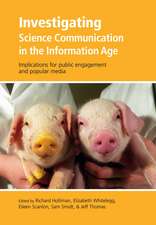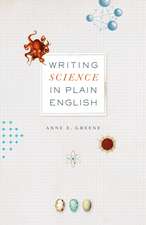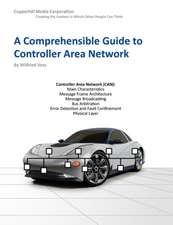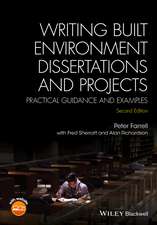Science and Technical Writing: A Manual of Style
Autor Philip Rubensen Limba Engleză Paperback – 13 dec 2000
| Toate formatele și edițiile | Preț | Express |
|---|---|---|
| Paperback (1) | 380.08 lei 6-8 săpt. | |
| Taylor & Francis – 13 dec 2000 | 380.08 lei 6-8 săpt. | |
| Hardback (1) | 1025.22 lei 6-8 săpt. | |
| Taylor & Francis – 19 dec 2000 | 1025.22 lei 6-8 săpt. |
Preț: 380.08 lei
Nou
Puncte Express: 570
Preț estimativ în valută:
72.73€ • 76.28$ • 60.55£
72.73€ • 76.28$ • 60.55£
Carte tipărită la comandă
Livrare economică 01-15 aprilie
Preluare comenzi: 021 569.72.76
Specificații
ISBN-13: 9780415925518
ISBN-10: 0415925517
Pagini: 464
Ilustrații: 100 colour illustrations
Dimensiuni: 152 x 229 x 25 mm
Greutate: 1.01 kg
Ediția:Revizuită
Editura: Taylor & Francis
Colecția Routledge
Locul publicării:Oxford, United Kingdom
ISBN-10: 0415925517
Pagini: 464
Ilustrații: 100 colour illustrations
Dimensiuni: 152 x 229 x 25 mm
Greutate: 1.01 kg
Ediția:Revizuită
Editura: Taylor & Francis
Colecția Routledge
Locul publicării:Oxford, United Kingdom
Public țintă
Professional Practice & DevelopmentNotă biografică
Philip Rubens is Professor of Technical Communications at East Carolina University.
Recenzii
"The book really shines when it tackles the specifics of science writing. The sections on scientific terms and symbols; technology terms; units of measurement; mathematical expressions; equations; and citations, notes, and references are invaluable for those who frequently deal with these issues." -- Bob Andrews,Technical Communication
Cuprins
1. Audience Analysis and Document Planning 2. Writing for Non-native Audiences 3. Grammar, Usage, and Revising for Publication 4. Punctuating Scientific and Technical Prose 5.Using Acceptable Spelling 6. Incorporating Specialized Terminology 7. Using Numbers and Symbols 8. Using Quotations, Citations and References 9. Creating Indexes 10. Creating Non-Textual Information 11. Creating Useable Data Displays 12. Designing Useful Documents.










